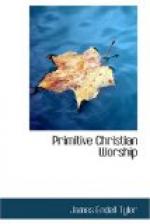The following then is the order in which the innovations in Christian worship seem to have taken place, being chiefly introduced at the annual celebrations of the martyrs:—
1st. In the first ages confession and prayer and praise were offered to the Supreme Being alone, and that for the sake of his Son our only Saviour and Advocate: when mention was made of saint or martyr, it was to thank God for the graces bestowed on his departed holy ones when on earth, and to pray to God for grace that we might follow their good examples, and attain, through Christ, to the same end and crown of our earthly struggles. This act of worship was usually accompanied by a homily setting forth the Christian excellences of the saint, and encouraging the survivors so to follow him, as he followed Christ.
2nd. The second stage seems to have been a prayer to Almighty God, that He would suffer the supplications and intercessions[19] of angels and saints to prevail {68} with him, and bring down a blessing on their fellow-petitioners on earth; the idea having spread among enthusiastic worshippers, as I have already observed, that the spirits of the saints were suffered to be present around their tombs, and to join with the faithful in their addresses to the throne of grace.
[Footnote 19: The Greek
word [Greek: presbeia], “embassy,”
employed on such occasions,
is still used in some eastern
Churches in the same sense.]




